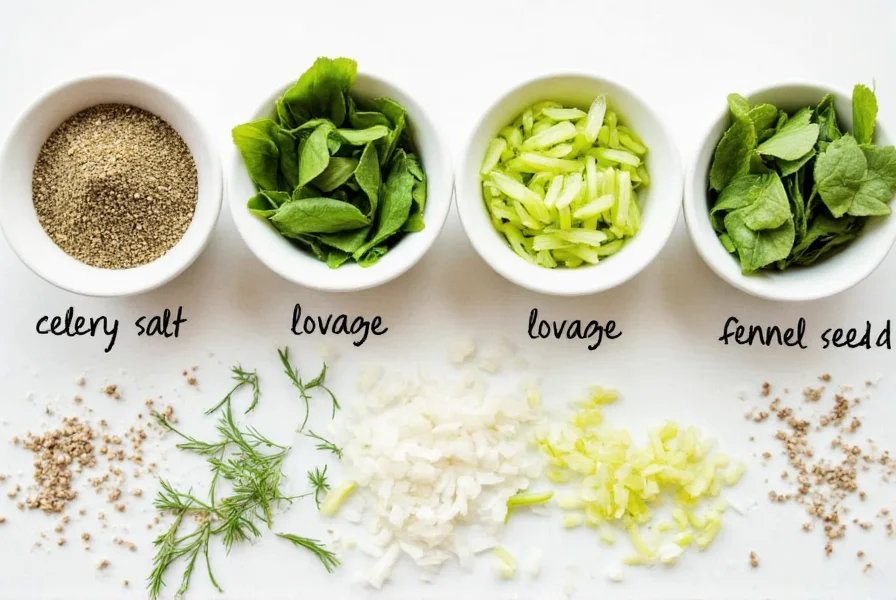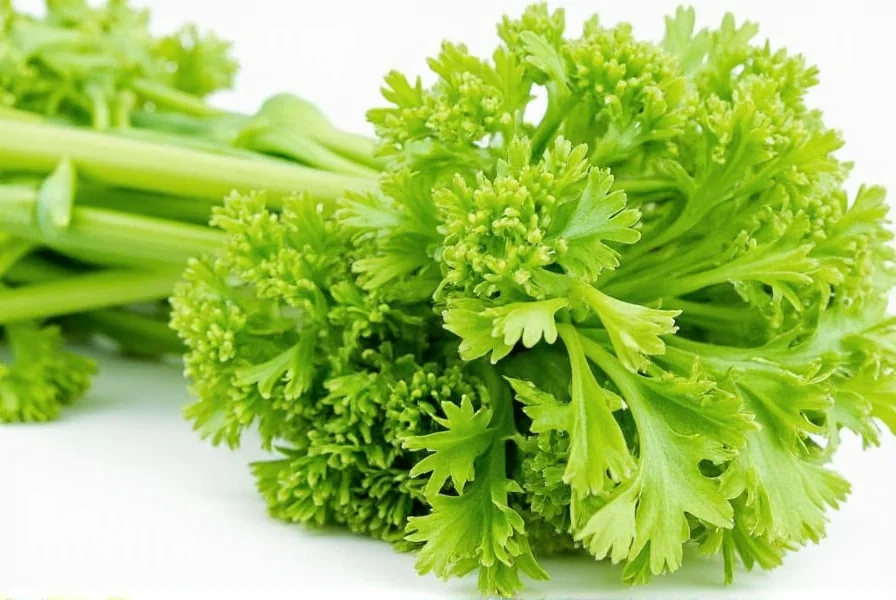The most effective alternatives for celery seed include celery salt (use 1/4 teaspoon for every 1/8 teaspoon of celery seed), fresh celery leaves (2 tablespoons finely chopped), lovage (1/2 teaspoon dried lovage equals 1 teaspoon celery seed), dill seed (use half the amount), and fennel seed (use sparingly as it has a stronger anise flavor). The best substitute depends on your specific recipe and dietary needs, with celery salt working well for soups and stews, fresh celery leaves providing a milder flavor for salads, and lovage offering the closest flavor match for most culinary applications.
When you're in the middle of cooking and realize you've run out of celery seed, knowing reliable alternatives can save your recipe. Celery seed has a distinctive flavor profile—earthy, slightly bitter, with subtle herbal notes—that's challenging to replicate exactly. However, several pantry staples can effectively stand in depending on your culinary context and flavor requirements.
Understanding Celery Seed's Unique Flavor Profile
Celery seed comes from the seeds of wild celery (Apium graveolens) and packs a more concentrated, intense flavor than the celery stalks we commonly use. It contains compounds like limonene and selinene that create its characteristic earthy, slightly peppery taste with hints of citrus. This complex flavor profile makes it a staple in many spice blends, pickling recipes, and vegetable dishes. When seeking alternatives, understanding these flavor components helps you select the best substitute for your specific culinary application.

Top 5 Alternatives for Celery Seed
1. Celery Salt
Celery salt combines ground celery seed with salt, making it an excellent substitute when you need both flavor and seasoning. For every 1/8 teaspoon of celery seed called for in a recipe, use 1/4 teaspoon of celery salt. This alternative works particularly well in soups, stews, and meat rubs where the salt content enhances overall flavor development. Remember to adjust additional salt in your recipe accordingly, as celery salt already contains sodium.
2. Fresh Celery Leaves
When celery seed isn't available, fresh celery leaves provide a milder but recognizable flavor profile. Use 2 tablespoons of finely chopped fresh celery leaves to replace 1 teaspoon of celery seed. This substitute works best in salads, dressings, and cold dishes where the fresh herbal notes complement other ingredients. The flavor is less concentrated than celery seed, so it won't overpower delicate dishes—a benefit when creating subtle flavor profiles in vinaigrettes or seafood preparations.
3. Lovage
Lovage offers the closest flavor match to celery seed, with a similar earthy, celery-like taste but slightly more intense. Use half the amount of dried lovage compared to celery seed (1/2 teaspoon lovage for 1 teaspoon celery seed). This herb works exceptionally well in vegetable stocks, potato salads, and pickling recipes where celery seed is traditionally used. Gardeners often grow lovage specifically as a celery seed alternative since it's easy to cultivate and provides fresh leaves throughout the growing season.
4. Dill Seed
Dill seed shares some flavor compounds with celery seed, offering a similar earthy profile with additional citrus notes. Use half the amount of dill seed compared to celery seed, as it has a stronger flavor. This alternative shines in pickling recipes, salad dressings, and fish dishes where the subtle anise notes complement other ingredients. While not identical, dill seed provides a pleasant flavor dimension that works well when celery seed isn't available.
5. Fennel Seed
Fennel seed offers a different but complementary flavor profile with its distinctive anise notes. Use sparingly—about 1/4 teaspoon fennel seed replaces 1 teaspoon celery seed—as its flavor is much stronger. This substitute works best in Mediterranean dishes, roasted vegetables, and certain bread recipes where the licorice notes enhance rather than overpower the dish. For those with celery allergies seeking celery seed alternatives, fennel provides a safe option with interesting flavor complexity.
| Alternative | Substitution Ratio | Best For | Flavor Notes |
|---|---|---|---|
| Celery Salt | 1/4 tsp = 1/8 tsp celery seed | Soups, stews, meat rubs | Salty, earthy, slightly bitter |
| Fresh Celery Leaves | 2 tbsp = 1 tsp celery seed | Salads, dressings, cold dishes | Milder, fresher celery flavor |
| Lovage | 1/2 tsp = 1 tsp celery seed | Vegetable stocks, potato salads, pickling | Stronger celery flavor, slightly more intense |
| Dill Seed | 1/2 tsp = 1 tsp celery seed | Pickling, salad dressings, fish dishes | Earthy with citrus notes, subtle anise |
| Fennel Seed | 1/4 tsp = 1 tsp celery seed | Mediterranean dishes, roasted vegetables | Distinct anise/licorice notes, stronger flavor |
Choosing the Right Alternative by Dish Type
Not all celery seed alternatives work equally well across different recipes. Understanding which substitute performs best in specific culinary contexts ensures your dishes maintain the intended flavor profile:
- For pickling recipes: Celery seed contributes to the characteristic flavor of many pickled vegetables. When celery seed isn't available, dill seed makes the best alternative for most pickling applications, providing similar earthy notes with complementary citrus undertones that enhance the pickling process.
- In soups and stews: Celery salt works exceptionally well as a celery seed replacement in liquid-based dishes. The salt content helps build flavor layers while the celery component provides the necessary herbal notes. Add it early in the cooking process to allow flavors to meld properly.
- For salad dressings: Fresh celery leaves or a small amount of finely chopped lovage provide the best celery seed alternative for dressings. These fresh options deliver the herbal notes without the concentrated bitterness that ground seeds can sometimes impart to delicate vinaigrettes.
- When cooking for celery allergies: For those with celery allergies seeking safe celery seed alternatives, fennel seed or a combination of parsley and a pinch of lemon zest can provide similar flavor dimensions without triggering allergic reactions.
Special Considerations for Allergies and Dietary Restrictions
For individuals with celery allergies, finding appropriate celery seed alternatives requires special attention. True celery allergies affect approximately 0.1-0.2% of the population and can cause serious reactions. In these cases, fennel seed provides a safe alternative with complementary flavor notes, though those with severe allergies should consult an allergist before trying substitutes that might cross-react.
Vegan cooks sometimes seek celery seed alternatives when recipes call for Worcestershire sauce (which traditionally contains anchovies) alongside celery seed. In these instances, combining lovage with a splash of vegan Worcestershire sauce creates a flavor profile that mimics the traditional combination without animal products.
Creating Your Own Celery Seed Substitute Blend
For frequent cooking needs, consider creating a custom celery seed replacement blend that you can keep in your spice cabinet. Combine equal parts dried parsley, dried dill weed, and a pinch of ground black pepper. Store in an airtight container away from light and heat. This blend works particularly well as a celery seed substitute for pickling and in vegetable dishes where the individual herb flavors complement rather than compete with other ingredients.
FAQ: Common Questions About Celery Seed Alternatives
What's the best celery seed substitute for someone with a celery allergy?
For those with celery allergies, fennel seed provides the safest alternative, using about 1/4 teaspoon fennel seed to replace 1 teaspoon of celery seed. The anise notes differ from celery's flavor profile but work well in many recipes. Alternatively, a combination of equal parts dried parsley and dried dill weed with a pinch of lemon zest creates a safe substitute that mimics some of celery's herbal characteristics without triggering allergic reactions.
Can I use celery seed alternatives in pickling recipes?
Yes, dill seed makes an excellent celery seed alternative for pickling recipes, using half the amount called for in the recipe. The earthy notes with citrus undertones complement vinegar-based pickling solutions well. For bread and butter pickles, consider using a combination of dill seed and a small amount of mustard seed to replicate the flavor complexity that celery seed typically provides.
How do I substitute fresh celery for celery seed in recipes?
Use 2 tablespoons of finely chopped fresh celery leaves to replace 1 teaspoon of celery seed. For best results, add the fresh celery near the end of cooking to preserve its delicate flavor. This substitution works particularly well in salads, dressings, and cold dishes where the fresh herbal notes enhance rather than overpower other ingredients. Note that fresh celery provides a milder flavor than the concentrated seed.
What's the difference between using celery salt versus celery seed in recipes?
Celery salt contains both ground celery seed and salt, typically in a 3:1 ratio of salt to celery seed. When substituting celery salt for celery seed, use 1/4 teaspoon of celery salt to replace 1/8 teaspoon of celery seed, and reduce additional salt in your recipe accordingly. Celery salt works better in soups, stews, and meat dishes where the salt content enhances overall flavor development, while pure celery seed provides more concentrated flavor without added sodium.
Which celery seed alternative works best for creamy dressings and dips?
Fresh celery leaves make the best celery seed alternative for creamy dressings and dips, using 2 tablespoons of finely chopped leaves per teaspoon of celery seed. The fresh, mild flavor blends well with dairy ingredients without overpowering the delicate balance of creamy dressings. For a more complex flavor profile, combine fresh celery leaves with a small amount of dried dill weed, which complements the creamy base while providing similar herbal notes to celery seed.











 浙公网安备
33010002000092号
浙公网安备
33010002000092号 浙B2-20120091-4
浙B2-20120091-4